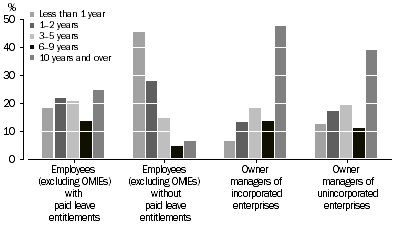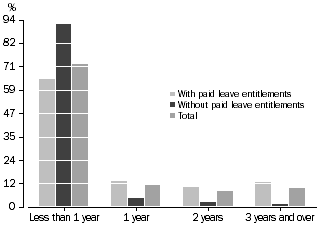SUMMARY OF FINDINGS
OVERVIEW
In November 2006, there were 10.1 million employed people aged 15 years and over. Of these, 61% (6.2 million) were employees (excluding owner managers of incorporated enterprises (OMIEs)) with paid leave entitlements. Of the remaining employed people:
- 2.1 million were employees (excluding OMIEs) without paid leave entitlements
- 673,700 were OMIEs
- 1.2 million were owner managers of unincorporated enterprises (OMUEs).
EMPLOYMENT TYPE
Employees (excluding OMIEs) with paid leave entitlements
Of the 6.2 million people who were employees (excluding OMIEs) with paid leave entitlements, 54% were men. Sixty-eight percent of employees (excluding OMIEs) actually worked 35 hours or more in their main job in the reference week. The industry with the highest proportion of employees (excluding OMIEs) with paid leave entitlements was Public administration and safety (90%). Twelve percent of employees (excluding OMIEs) with paid leave entitlements were in the Health care and social assistance industry, and a further 12% were in the Manufacturing industry. Just under one quarter (24%) of employees (excluding OMIEs) with paid leave entitlements were Professionals.
Employees (excluding OMIEs) without paid leave entitlements
About 75% of employees (excluding OMIEs) without paid leave entitlements worked less than 35 hours in their main job in the reference week, while 37% worked less than 15 hours. Of employees (excluding OMIEs) without paid leave entitlements, 56% were women, 21% worked in the Retail trade industry, while 23% were Labourers.
Owner managers of incorporated enterprises
Approximately 69% of OMIEs actually worked 35 hours or more in their main job in the reference week, while 40% worked 49 hours or more. This compares with 12% of employees (excluding OMIEs) who worked 49 hours or more. Other characteristics of OMIEs in November 2006 included:
- 71% were men
- 31% were aged 45-54 years
- 18% worked in the Construction industry and 14% worked in the Professional, scientific and technical services industry
- 36% were Managers and 20% were Professionals.
Owner managers of unincorporated enterprises
An estimated 12% of employed people were OMUEs in their main job. Of these, 59% actually worked 35 hours or more in their main job in the reference week, while 31% worked 49 hours or more. Other characteristics of OMUEs in November 2006 included:
- 67% were men
- 21% worked in the Construction industry and 14% worked in the Agriculture, forestry and fishing industry
- 26% were Managers and 25% were Technicians and trades workers.
EMPLOYED PEOPLE
Continuous duration with current employer/business
Twenty-four percent of employed people had been with their employer/business for 10 years or more.
EMPLOYED PEOPLE, Continuous duration with current employer/business - By employment type

Owner managers and employees (excluding OMIEs) with paid leave entitlements most commonly reported that they had been with their current employer/business for ten years or more. In contrast, nearly half (46%) of employees (excluding OMIEs) without paid leave entitlements had been with their current employer/business for less than one year.
Expected future duration with current employer/business
Most (90%) employed people in November 2006 expected to be with their current employer or business in 12 months time.
Of employees (excluding OMIEs) without paid leave entitlements, 22% did not expect to be with their current employer in 12 months time. This compares with 7.6% of employees (excluding OMIEs) with paid leave entitlements, 5.7% of OMUEs, and 3.2% of OMIEs.
Hours actually worked in main job
Just under one-quarter (24%) of employed people actually worked 45 hours or more in their main job in the reference week. Of these, 61% were employees (excluding OMIEs) with paid leave entitlements and 33% were owner managers.
Worked on a contract basis
There were 1.5 million employed people who worked on a contract basis in November 2006. Of these, 1.1 million were employees (excluding OMIEs), of which 16% worked in the Health care and social assistance industry, 16% worked in Education and training and a further 9.8% worked in the Retail trade industry. Almost one-third (32%) of employees (excluding OMIEs) who said they worked on a contract basis were Professionals, followed by Clerical and administrative workers (14%). Fifty-two percent of employees (excluding OMIEs) who worked on a contract basis were women.
More than one-third (36%) of the 409,800 owner managers who worked on a contract basis worked in the Construction industry and 15% worked in the Professional, scientific and technical services industry. Of owner managers who worked on a contract basis, 34% were Technicians and trades workers and 20% were Professionals. Eighty percent of owner managers who worked on a contract basis were men.
EMPLOYEES (excluding OMIEs)
The majority (89%) of employees (excluding OMIEs) without paid leave entitlements considered their main job to be casual (92% of women and 85% of men).
Full-time workers in main job
An estimated 62% of employees (excluding OMIEs) were full-time workers in their main job. Most employees who were full-time workers in their main job had paid leave entitlements (89%). The industry group in which the highest proportion of them had paid leave entitlements was Financial and insurance services (97%) followed by Education and training (95%). The occupation where they were most likely to have paid leave entitlements was Managers (95%). The industry group in which the highest proportion were without paid leave entitlements was Agriculture, forestry and fishing (36%) followed by Accommodation and food services (27%). The occupation group where the highest proportion were without paid leave entitlements was Labourers (29%).
Part-time workers in main job
Approximately 38% of employees (excluding OMIEs) were part-time workers in their main job. Just over half of employees who were part-time workers in their main job had paid leave entitlements (52%). The industry group in which the highest proportion of them had paid leave entitlements was Electricity, gas, water and waste services (87%) followed by Mining (85%). The occupation group with the highest proportion was Managers (76%). The industry group in which the highest proportion were without paid leave entitlements was Accommodation and food services (83%) followed by Agriculture, forestry and fishing (76%). The occupation group where the highest proportion were without paid leave entitlements was Sales workers (71%).
Length of set employment completion date/event from the date of interview
There were 526,600 employees (excluding OMIEs) whose employment had a set completion date/event. Of these 72% had paid leave entitlements in their main job.
EMPLOYEES (excluding OMIEs) WHO HAD A SET EMPLOYMENT COMPLETION DATE/EVENT, Whether had paid leave entitlements - By length of set employment completion date/event from the date of interview

There were 146,000 employees (excluding OMIEs) who were without paid leave entitlements and their employment had a set completion date/event. Of these, 92% had a set completion date/event of less than one year from the date of interview. There were 380,600 employees (excluding OMIEs) who were with paid leave entitlements and their employment had a set completion date/event. Of these, 36% had a set completion date/event of one year or more from the date of interview.
Worked on a fixed-term contract
There were 287,100 employees (excluding OMIEs) with paid leave entitlements who worked on a fixed-term contract. Of these, 79% expected their contract to be renewed upon completion. In comparison, there were 91,800 employees (excluding OMIEs) without paid leave entitlements who worked on a fixed-term contract. Of these, 60% expected their contract to be renewed upon completion.
 Print Page
Print Page
 Print All
Print All